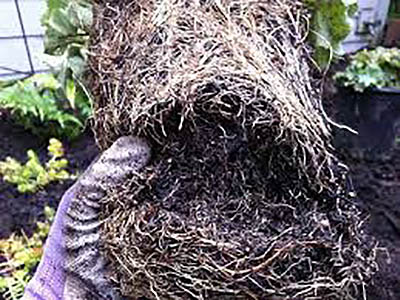
(above) President of The Rahway Garden Club, James Keane has been researching and answering garden questions since 1995. Visit ‘Keane Gardener’ blog at: keanegardener.blogspot.com
When we purchase a plant in a garden center we try to choose the healthiest one we can find and ponder its potential without considering its most essential component, the root system. When a seed germinates and begins its life journey, the first part to sprout is a tiny root.
Unlike in nature where the roots have pl enty of space to spread out, plants in containers have little area and the roots gro w in to themse lve s becomin g entw ine d together. This pro ble m i s known as ‘root-bound’. The root-ball will not be able to grow outward in search of wa ter and nutrients and will slowly choke itself.
BREAK THE ROOT BALL
The solution to this problem is simple, break op en the root ba ll . T his te chnique can be intimidating t o peopl e w ho don’t wa nt to harm the plants the y just pu rchased. You will d o far more damage by leaving the roots as they are.
The b ound roots w il l stun t t he gro wth of vegetables and flowers. Less water means lower pr oductivity or simply p ut sma ller tomatoes. Trees, shrubs and bu shes will even tuall y show damage of dying twigs and branches.
Breaking the root ba ll can be done quickly, esp ecially in s maller plants such as annuals of vegetables or flowers grown in cell packs. When you lift the plant out of the pack pull the lower roots apart, actually breaking them so they will spread out when they are planted.
This general idea is the same for larger potted shrubs and trees. Larger root systems might need to be hit with a shovel or cut with a knife to get the thick roots to break apart.
The day before planting water plants well. Soaking will prepare them for the process about to take place.
Before planting research and follow all special instructions for your plants. Follow recommendations including correct depth for that species. Some shrubs need to be dug deeper while others need to be a few inches above the soil line. This will ensure that your new plant will settle for years of healthy growth.
After you have planted, water the plant well. This process is called ‘mudding in’. It is difficult for newly planted shrubs to get water and nutrients from the root system in the ground up to the plant leaves and branches.
When plants show problems we call it ‘transplant shock’. The first year of growth takes place underground. Don’t worry if you notice slow growth or smaller plants. They will show great improvement the next year.
Water well the first year and avoid drying out. At least one inch of water every week for most plants. Perhaps a little more for new transplants during dry spells.
Happy Gardening,
James

(above) Breaking apart the root ball will help plants absorb water and nutrients for robust growth and healthier plants.
